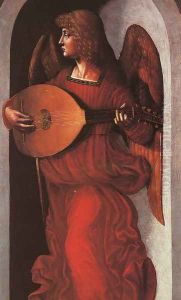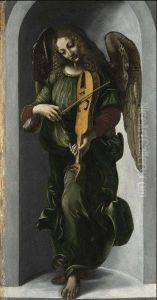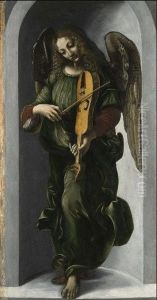Associate of Leonardo da Vinci Paintings
Leonardo da Vinci, born on April 15, 1452, in Vinci, Italy, is universally acknowledged as one of the most gifted and versatile geniuses in history. The illegitimate son of a notary, Piero da Vinci, and a peasant woman, Caterina, Leonardo was raised in the Vinci countryside. His early education was handled by the family and included the basics of reading, writing, and arithmetic. By the age of 15, Leonardo's artistic talents were evident, leading his father to secure him an apprenticeship with the renowned artist Andrea del Verrocchio in Florence. This period was crucial for Leonardo's development, as he was exposed to a wide range of technical skills, including painting, drawing, sculpting, and mechanical arts.
Leonardo's work with Verrocchio, especially on the painting of 'The Baptism of Christ,' showcased his exceptional ability, notably in his contribution of the young angel holding Jesus’ robe. His talents surpassed those of his master, marking the beginning of his lifelong journey of artistic and scientific exploration. By 1478, Leonardo had established his own workshop, but it wasn't until 1482 that he moved to Milan to work for the ruling Sforza family. His time in Milan was productive, resulting in several significant works, including 'The Last Supper,' a masterpiece of mural painting that captures the emotional intensity of Jesus announcing one of his disciples would betray him.
Leonardo's interests were not confined to art alone; his notebooks reveal a mind deeply fascinated by the workings of nature, the human body, and mechanical devices. His studies in anatomy, for example, were groundbreaking, based on meticulous dissections and detailed drawings that remain some of the most sophisticated anatomical sketches ever produced. Similarly, his designs for machines – such as flying devices, armored vehicles, and solar power – though never built in his lifetime, are celebrated for their innovative vision.
Despite the breadth of his interests, Leonardo completed relatively few paintings, often leaving works unfinished, as his curiosity drove him from one study to another. In 1513, he entered the service of Giuliano de' Medici in Rome, where he had the opportunity to study classical antiquities and continue his scientific explorations. His final years were spent in France, under the patronage of King Francis I, who provided him with the Château de Cloux (now Clos Lucé) near the king's residence at the royal Chateau d'Amboise. It was here that Leonardo spent his last years, continuing his studies until his death on May 2, 1519.
Leonardo da Vinci's legacy is immense, transcending the realms of art and science. His visionary ideas and artworks continue to inspire admiration and study, underscoring his status as a true Renaissance man whose curiosity and intellect knew no bounds.


